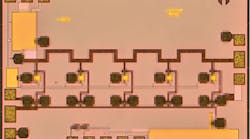Low-noise amplifiers (LNAs) are usually designed for specific frequency ranges. But when a single amplifier is needed for a host of applications, model CMD206 is a GaAs monolithic-microwave-integrated-circuit (MMIC) amplifier from Custom MMIC that can cover quite a bit of ground. The single-die LNA provides more than 11-dB small-signal gain from DC to 50 GHz with typical noise figure of 3.5 dB or less across that wide frequency range. The distributed GaAs MMIC amplifier, which is matched to 50-Ω impedance, is fully passivated for moisture protection and high reliability and can be used in a variety of applications ranging from portable radios to test equipment.
The model CMD206 LNA exhibits input return loss of typically 20 dB at 30 GHz along with output return loss of typically 10 dB at the same test frequency. It delivers an output 1-dB compression point of +12 dBm at 30 GHz and draws typical supply current of 32 mA at 30 GHz when running on +4-VDC and +3-VDC drain and gate voltages. The typical gain ranges from 10 dB across a span of DC to 30 GHz to 12 dB from 30 to 50 GHz. The typical noise figure is 4 dB from DC to 10 GHz, 3.5 dB from 10 to 30 GHz, and 4.5 dB from 30 to 50 GHz. The output power at 1-dB compression is typically 12.5 dBm from DC to 10 GHz, +13 dBm from 10 to 30 GHz, and +10 dBm from 30 to 50 GHz. The output third-order intercept point is typically +21 dBm from DC to 10 GHz, +22 dBm from 10 to 30 GHz, and +18 dBm from 30 to 50 GHz.
For ease of mounting, the back side of the 85-μm-thick die is RF ground. The chip amplifier is rated for maximum RF input power of +20 dBm, maximum drain voltage of +6 VDC, and maximum gate voltage of +4 VDC. It can be used across an operating temperature range of -55 to +85° C with only slight variations in gain and noise figure because of temperature changes. In fact, users can predict these variations as functions of the LNA’s gain and noise-figure temperature coefficients. The gain temperature coefficient is 0.008 dB/° C from DC to 10 GHz, 0.012° C from 10 to 30 GHz, and 0.023° C from 30 to 50 GHz. The noise figure temperature coefficient is also low, at 0.008 dB/°C from DC to 10 GHz, 0.008 dB/°C from 10 to 30 GHz, and 0.012 dB/°C from 30 to 50 GHz. The tiny device is rated for 712 mW maximum power dissipation, with a thermal resistance of 91.2°C/W.
Custom MMIC, 1 Park Dr., Unit 12, Westford, MA 01886; (978) 467-4290, FAX: (978) 467-4294
